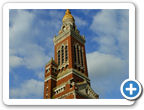The Western Front Today - Albert
In 1914 Albert had over 7,000 inhabitants; by 1919 there were just 120.
Fierce fighting took place around Albert from the earliest days of the war, in September 1914. Albert was a major control centre for the planning of the Somme battle.
However, by the close of that battle in the autumn of 1916 the town itself had largely been reduced to a pile of rubble.
Albert remained in allied hands right up until the great German push of
Spring 1918, when it was taken on 26 March. It was recaptured by the British
on 22 August, just under five months later.
At the heart of the town, both then and now, is the Golden
Madonna basilica. Before the war 'la Basilique' was a popular tourist
attraction, with the golden figure of the Virgin Mary holding aloft the baby
Jesus.
Allegedly found by a shepherd in the middle ages the statue was credited with miraculous properties and consequently received many pilgrims.
By the end of the nineteenth century Albert was so popular that Pope Leo XIII called it 'The Lourdes of the North'.
In January 1915 German shelling toppled the statue perilously to an angle horizontal to the ground.
However the statue did not fall. Superstitious legends sprang up on both allied and German sides.
The British and French believed that the war would end of the day that the tower came crashing down; and the Germans believed that whomever caused the statue to fall would inevitably lose the war; both sides therefore took care not to aim shells at the tower holding the statue.
This arrangement suited the allies since the tower provided a valuable vantage point from which to view the opposing German forces.
As it turned out the British eventually destroyed the tower during the German occupation of the town in Spring/Summer 1918. The statue itself was never discovered after the war, and a replica basilica was completed to the original design. Underneath the basilica tower today is a fine WW1 museum.
References:
Before Endeavours Fade, Rose E.B. Coombs, After the Battle 1994
Major & Mrs Holt's Battlefield Guide - Somme, Leo Cooper 2000
A "biff" was a Bristol fighter plane.
- Did you know?



